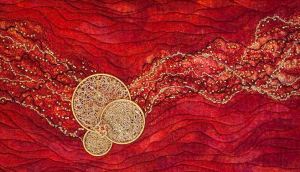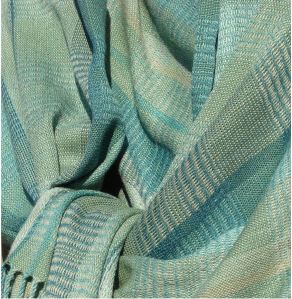Experimental artist

______________________
This past year, a new focus is emerging for Tonnie Wolfe. The emphasis remains on experimentation, but her focus is narrowing somewhat to incorporate more fiber and less acrylic paint and found objects. With limited motion in her right arm this past year, Tonnie has been working smaller and with less stitching and felting, but she’s added crochet to the repertoire. You can expect to see some fiber jewelry at the tour, and more digital art, resulting in an offering of prints and cards from her original designs.
_________________
Influences:
LH: Did you grow up in an artistic family?
TW: My art has been in transition these past two years. I’ve become more interested in the creativity expressed in my family…sewing, tatting, crochet, quilting, cooking, and gardening. I am realizing how much influence my family actually has had on my creativity and art. I am currently exploring the use of these traditional crafts, but applying them in contemporary ways. I feel much more a part of generational patterns of creativity expressed through women’s handwork. This type of work has not been considered “real art.” Yet when we really think about what women have created from scraps of fabric and hand spun yarn, it is really quite amazing. Blankets could have been made without the piecing and hand quilting. Sweaters could have been knit or crocheted without the beautiful pattern work. I am grateful for the connection to this type of creativity and innovation.
LH: Who are the artists that influence your work that you know in person?
TW: My grandmother was a role model. She gardened, made bread and homemade pasta, crocheted, tatted, sewed, and came up with creative costumes at the last minute. My aunt was an amazing seamstress and was a support as I learned to sew on my grandmother’s treadle machine. Another aunt was a sculptor and crafter; she was the “wild child” of the family, loved but not emulated. In my adult life, I have been most supported by the community of artists in Edmonds. The encouragement of this community has helped me gain skills and confidence as an artist.
LH: Name a living artist who you flat-out LOVE and think more people should go to see their work.
TW: I have recently begun to enjoy free form and Irish crochet. Prudence Mapstone of Australia is an amazing crochet artist I’ve come to admire. (http://www.knotjustknitting.com/) I still love and am influenced by Maggie Grey (http://magstitch.blogspot.com/), and Karin Schminke (http://schminke.com/).
LH: Who is your favorite artist(s)? Style? Period?
TW: The fiber artists from Great Britain and Australia remain a great influence. Their exploratory methods in fiber and mixed media have greatly informed my own work. Locally, Gail Harker has been influential. She is a product of City and Guilds in Great Britain; she teaches locally from her school in LaConner.
LH: In what ways does the place where you live (or places where you have lived), affect the art you create, or your artistic preferences?
TW: A second studio space on our property is in the process of being completed. This will make working in various media much easier as I’ll have more room to spread out and store my equipment and supplies.
LH: You’ve lived here most of your life? How has that shaped your art?
TW: I am a home body. Family, friends, studio, garden…these are what feed me. Perhaps that is why my work is experimental…I experience exploration through experimentation. (How’s that for an alliterative sentence?)
Artistic direction:
LH: When is the first time you realized you were an artist?
TW: I finally claimed the title of artist about 10 years ago. I had a 40-year career as a nurse. It took about 5 years to be able to transition from identifying with nursing to identifying with art. Much of my career was spent working with families facing some type of challenge with their children. Working with these children has strongly influenced my work as an artist. Families facing the unthinkable, like a child with cancer or a severe disability, don’t need to be challenged by the art they view. Healing for these families lies in beauty, nature, love…momentary respites from the reality they are living with. That is what I hope my art offers, to experience beauty and engagement with a piece that takes the viewer out of daily life, even if it is just for a moment.
LH: Describe your first (or alternatively, most recent) artwork.
TW: I recently finished a small, crocheted “coral reef” project using some hyperbolic crochet. For those interested in math, check out why crochet is being used to reflect some of the newer math models. Hyperbolic crochet is fun to look at and make. Luckily, I don’t need to UNDERSTAND the math it represents.
LH: Why are you drawn to fiber and computer art?
TW: I am a kinesthetic learner. Touch is really important…hence texture and fiber. I am also fairly centered in the right-left brain continuum. Computer art feeds my left brain as does learning about different media and techniques used in the experimental aspect of my work. My art is fairly intuitive without a lot of planning and that feeds the right brain as does the “doing” part of experimental work.
LH: I’ve noticed that certain color and texture appear often in your work. What attracts you to them?
TW: Color and texture = nature and touch. The rest just shows up. I am more likely to explore the meaning in a single piece and not my body of work. I notice that circles seem to recur as do Asian compositions. Perhaps I’ll explore this at some point.
LH: How do you balance your art with other obligations – mate, children, job?
TW: I am currently retired. However, I fell into the trap that many retirees do – over-committing to others. For the past year, I’ve slowly let go of most obligations outside my home and studio. This has freed me to move into a transitional period with my art. As the grandmother of a 4-year-old, I also wanted to have plenty of time to be a part of her life.
LH: What are you up to right now? Current or upcoming projects, shows, experiments, collaborations, etc.
TW: For the past year, I’ve been on hiatus while I have taken care of my aging skeleton. During this time, I’ve returned to some familiar and comfortable handicrafts. I’ve made some clothes for my granddaughter, taught myself to crochet, and took online classes to explore new ways to create digitally. Per above, my focus is changing to primarily using fibers and fabrics. I am beginning to get back to more original design work. Right now, I am working on a piece that incorporates hand-made felt, hand-dyed fabric, crochet, beading and quilting. It will incorporate some of the flowers I’ve been crocheting, along some with crocheted mesh.
LH: What’s your ultimate direction for your art? Where do you see yourself in 5 years, 10 years?
TW: The new direction that is emerging is using traditional handcrafts in new ways. I continue to experiment and use a mix of media, but the media seems to be mostly some form of fiber. With a new studio space on the near horizon, I will have space to set up wirework again. I may have some new jewelry pieces at the studio tour. The only thing I can say beyond this year is that I will keep creating. It’s essential to my well-being.
LH: What aspect of making art excites you the most right now?
TW: Freedom! By releasing so many obligations and just working regularly in the studio, I’ve given myself the time and space to explore and expand. “Not knowing” is a great place to be. I am able to have an idea then explore it. I am led by the art rather than trying to force a piece for sale or a show. As a result, I believe my art is more authentic and attractive to the viewer.
Teaching:
LH: Tell me about the classes that you teach and your interaction with students.
TW: I teach both fiber art and mixed media classes, though right now I am taking a bit of a hiatus. Teaching opportunities keep showing up. Most recently, I’ve taught a class on creating and using stencils and on using computerized embroidery for applique and embellishment. I teach individually in my studio, as well.
Surroundings:
LH: What music do you play, if any, while making art?
TW: If I play music, it is either classical or contemporary instrumental/orchestral pieces or music I can sing along with (Dan Fogelburg, Simon and Garfunkel, Broadway musicals). But mostly, I am quiet.
LH: What is it like to be an artist in Edmonds?
TW: I am grateful to be an artist in Edmonds. I feel supported and energized by the group. There is a generosity that I admire.
Wishes and Wants
LH: When someone is viewing your work for the first time, what do you hope they’ll see in it? Or, what do you want them to say about your work?
TW: I hope that the observer will be drawn into and experience the piece, if just momentarily. I love when there is some curiosity, whether about the subject or technique. I enjoy seeing the viewer with their nose up near my art and a finger reaching out to examine the surface.
LH: What is one art tool or supply that you would take to your proverbial desert island?
TW: As a mixed media artist, how could I live with just one? I guess I’d need a solar powered computer and camera. That would allow me to create in a variety of ways.
LH: If you could take a fantasy artist vacation anywhere in the world, where would it be? Your goal would be to soak in art history or to make your own art. Where would you go?
TW: I would go to a quiet cabin preferably in the woods near water. I would spend a whole month creating my own work, walking, writing, canoeing, swimming, and resting. Since this is my fantasy, there would also be a gourmet cook to deliver healthy and delicious food and a team of invisible clean-up fairies to keep the place tidy. And as long as I’m in this fantasy, I’d like to have regular visits from a massage therapist and yoga teacher.
________________________
Contact:
Tonnie Wolfe
Studio 18
tonniewolfe.com
tonnie@tonniewolfe.com


